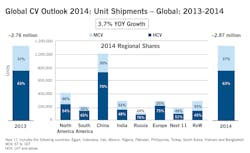Key structural modifications occurring in the global medium and heavy duty truck market
Based on our comprehensive analysis of global commercial vehicle markets, customers, OEMs and tier-1 suppliers, Frost & Sullivan is projecting sales of 2.87 million medium and heavy duty trucks in 2014. This implies that the global markets will absorb 110,000 additional units – a 3.7 percent growth over 2013 – and there will be a 3.2 to 3.7 percent global GDP growth.
North American Class 8 truck sales are projected to reach their highest levels in the past six to seven years. We are forecasting heavy duty sales of approximately 258,000 units; medium duty truck sales will exceed 140,000 units.
Globally the heavy and medium duty truck sales ratio will remain unchanged relative to last year at 1.7:1. Chart A shows the 2013 to 2014 comparative analysis of medium and heavy duty truck sales in the global marketplace.
Electronics and Technologies
Also, this is the year when global engine platforms will truly take flight as global platform strategies of the major truck OEMs will experience continued momentum. These will gain focus, with a steady flow of new truck platform/model introductions. At least 15 new truck models in the medium and heavy category will be launched in 2014.
What will go largely unnoticed will be the rising proliferation of distributed electronics in medium and heavy duty trucks. The OEMs’ recognition of change in truck sales models from a transactional to relational format will continue stoking investments in multiplexing technologies geared at facilitating ingress of soft technologies in trucks.
With TCO (total cost of ownership) becoming a major consideration of truck buyers in both developed and developing markets, the stage is getting set for rapid and profound penetration of connectivity technologies in commercial vehicles. These technologies will not only catalyze mobile resource management, but will also usher vehicle-to-infrastructure, vehicle-to-vehicle and related communications aimed at enhancing vehicle uptime, driver satisfaction and fleet efficiency and safety.
While market observers will be delighted at growth in truck sales in key markets, industry observers will realize the importance of 2014 in bringing together the amalgamation of green, safe and smart as the triad for future commercial vehicle design and development. Advanced telematics solutions – such as prognostics, green powertrain technologies like natural gas and advanced diesel engines married with advanced AMTs (automated manual transmissions) – and safety enhancement technologies, such as stability control systems, will continue gaining global adoption.
“Value Trucks”
Our study, Strategic Outlook of Global Medium-Heavy Duty Tuck Market in 2014, also indicates the emergence and solidification of a new trend: the rise of “value trucks.”
For the past 10 years, the global medium and heavy truck market benefited heavily from new truck sales in the BRIC (Brazil, Russia, India and China) markets. However, these trucks were mostly low-cost trucks offering little applicability and margin potential to the global truck OEMS and tier-1 suppliers.
The economic progress in emerging markets, supported to some extent by these low-cost trucks, particularly in BRIC markets, has started to usher in value trucks in these markets. Value trucks are typically priced 30 percent lower than premium trucks and 15 to 20 percent higher than low-cost trucks.
Value trucks are already making inroads in markets such as China, India and Russia. This category of trucks is expected to grow at one of the fastest rates in the global commercial vehicle market because they deliver better fuel economy, safety, comfort, convenience and TCO than low-cost trucks.
It is unlikely that the march of value trucks will render low-cost trucks unattractive in emerging markets. While value trucks enter and thrive in BRIC markets, low-cost trucks will experience ample and growing demand in several Next 11 and African markets, in addition to BRIC and other emerging markets for at least the next 10 to15 years.
Truck Service and Maintenance
Another noticeable trend in both developed and developing markets is the rising involvement of OEMs in the quality used truck market. OEMs are realizing the need for greater integration of digitization in both new and used truck retailing in gaining more touch points with truck buyers and also for influencing their purchase decisions.
Digitization will also increasingly encompass truck service and maintenance as e-retailers, such as Amazon and others, will increasingly encroach into the truck parts market offering lower cost parts delivered at low cost, sometimes at no cost, enabling mission- and time-critical maintenance. Big data will enable several of these new retailing initiatives.
Structural modifications are already in motion which will make 2014 a year of great relevance in the development and introduction of future-focused trucks and associated powertrain, chassis, safety, telematics and regulation compliance technologies.
This is the year when several predictive maintenance and prognostics based technologies and initiatives will be introduced in North America and Europe.
This will drive fleet maintenance managers towards eventually integrating data from prognostics and other telematics services to their service and maintenance models to enhance uptime and improve overall fleet mobile resource productivity. That, in turn, will elevate overall freight and fleet efficiency in North America.
About the Author

Sandeep Kar
Global Director, Automotive and Transportation Research, Frost & Sullivan
Sandeep Kar is global director of automotive and transportation research for Frost & Sullivan. He leads a team of analysts that research and analyze automotive technologies, economics, applications and markets, with special focus on global commercial vehicle industry. Frost & Sullivan (www.frost.com) works in collaboration with clients to leverage visionary innovation that addresses the global challenges and related growth opportunities that will make or break today's market participants.
